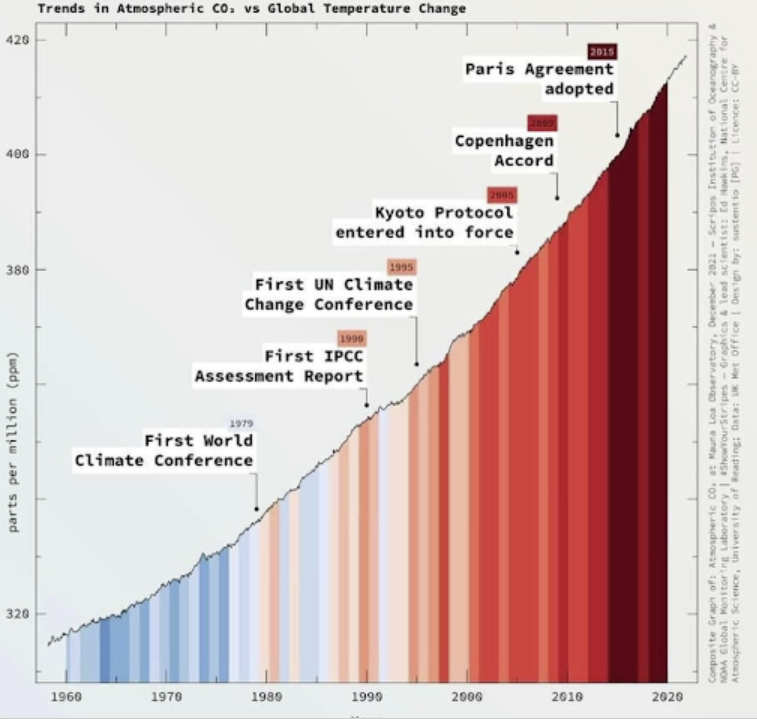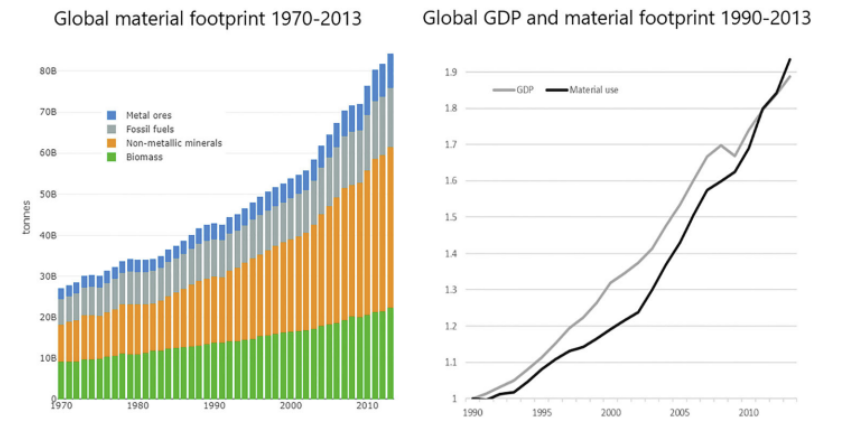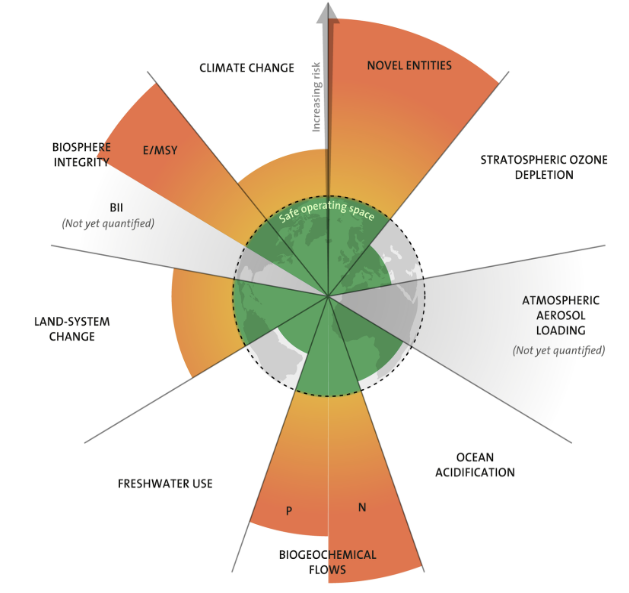· 11 min read
“We can decouple growth from environmental pressures.” “Technological innovation will give us a sustainable economy and that’s why we need growth.” “We can have sustainability and growth at the same time” When in the midst of a heated conversation over solutions to the ecological crisis, there will always be that one person bringing up a sentences like this. Fasten your seatbelts, you have found yourself what we like to call a ‘green growth’ thinker.
Green growth thinking is rooted in what is known as ‘ecomodernism’: the belief that there are no limits to growth since there are no limits to human ingenuity. In fact, we would need growth to find solutions to the problems with ‘the environment’ (that external thing out there) we are facing. Why? Because growth will bring us the technological wonders to innovate ourselves out of the ecological mess we are in. Through growth, we can scale up renewable energy, invest in technologies that can suck carbon out of the air and store it into the ground. Through shifting towards a circular economy, we can ‘decouple’ our economic activities from environmental pressures. So: “yes, we need to tackle the ecological crisis and strive towards a circular economy, but we can and need to keep growing our economies at the same time.”
The thing with green growth is, you will not only come across it in your private quarrels on how to fix the biggest challenge of our time. In fact, green growth thinking is promoted by leading multilateral organisations and is assumed in national and international policymaking, including the IPCC reports and the Paris Agreement.
In this article, I hope to provide an overview of why green growth is a dangerous myth that should be thrown out of the window as fast as possible. First, the very foundation on which green growth thinking is based, namely the idea of ‘uncoupling’, doesn't stand up to scrutiny once we unpack it. Second, capitalism’s growth logic is rebounding efficiency gains. Third, green growthers reason with a ‘carbon tunnel’, leading them to give reductionistic solutions to environmental issues that demand holistic ones.
Every year emissions rise, still
First, let’s start with some facts: at present, seven years after the Paris Agreement was made to keep global temperatures below 1.5 degrees, CO2 emissions are still rising. The Global Energy Report of the International Energy Alliance published this week showed that energy-related CO2 emissions grew to 36.3 Gt in 2021, a record high. To put this in perspective: the IPCC has calculated that with emissions rising at these levels, at best we have a 50% chance of limiting warming to below 1.5 degrees. This implies that we will have depleted this carbon budget in less than 8 years from now.

To reconcile this fact, both models that form the base of the Paris Agreements and scenarios assessed in IPCC reports assume massive carbon dioxide removal to the scale of 100 to 1000 billion tonnes of CO2 until 2100, predominantly through a technique often abbreviated as bioenergy and carbon capture and storage, or BECCS. The idea is that through BECCS, we can decouple the growth of our economies - measured in GDP - from emissions and resource use, and as such make growth ‘clean’. When politicians are talking about ‘net zero emissions’, this is what they mean.
Unfortunately, this high trust in decoupling has no empirical grounding.
Decoupling of what?
When having a discussion with "green growthers" about decoupling, be aware of the terminology used. First of all, there is a need to be clear about the difference between relative and absolute decoupling. Relative decoupling refers to a situation where emissions are still rising, only to a lesser extent (the slope of the still rising curve has flattened a bit), while GDP continues to rise. Absolute decoupling on the other hand refers to a situation where emissions are going down, while GDP goes up. At present, we are seeing that many rich nations are in a situation of relative decoupling.
Importantly, in cases where relative decoupling is taking place, we must be mindful of the extent to which this is influenced by the geographical disjuncture between where production takes place and where GDP is captured. Furthermore, relative decoupling is often the consequence of one-off changes - the ‘low hanging fruits of the transition’ - such as the substitution of coal with natural gas. It is much harder to sustain this relative decline of the rate of emissions once this phase is over, especially in a scenario where energy demand continues to grow exponentially.
Moreover, in decoupling discussions, there tends to be a big emphasis on the decoupling of carbon emissions, or ‘decarbonization’. However, when talking about decoupling the impact our economy has on our planet’s ecology, we also need to talk about decoupling of resource use, or ‘dematerialization’. As discussed below, while absolute decoupling of emissions is happening at some places, there are almost no cases of the absolute decoupling of resource use.
Green growth has no scientific grounding
In 2020, a team of researchers performed an extensive systematic review looking into 835 peer-reviewed articles and found that there is no empirical evidence of absolute decoupling of emissions at regional and global level. Moreover, modelled projections indicate that with existing growth trajectories, this is unlikely to be achieved. GDP growth remains significantly coupled with carbon emissions.
At the national level, there are some cases of absolute decoupling. A study often cited to acclaim green growth and to prove decoupling shows that between 2005 and 2015, 18 countries (Sweden, Romania, France, Ireland, Spain, UK, Bulgaria, The Netherlands, Italy, United States, Germany, Denmark, Portugal, Austria, Hungary, Belgium, Finland, and Croatia) have decreased their CO2 emissions with 2.4% per year. This is good news, but unfortunately, not as good as green growthers claim it to be. In fact, it is only one third of the reductions in emissions that are needed at a global level to limit global warming to 1.5 degrees. Moreover, part of that decrease can be explained by a slowdown in GDP growth rates of the countries where absolute decoupling was observed.
As for resource use, empirical records demonstrate a similar strong relationship between GDP and material footprint. Towards the end of the twentieth century GDP grew at a faster rate (3 percent per year) than resource use (2 percent per year), which represents a small relative ‘decoupling’. But this changed in the 21th century, when the growth rate of global consumption accelerated and so did global resource use, to 3.85 percent per year, a bigger increase than GDP in the same period, meaning that the material intensity of the global economy has in fact increased during that period. As the authors of one of the most extensive studies looking into this put it: ‘Currently, the world economy is on a path of re-materialization and far away from any – even relative – decoupling.’ Meanwhile, modelled scenarios show that under growth-as-usual conditions absolute reductions in resource use are unlikely to be achieved at a global level even with dramatic efficiency improvements.

In sum, as the authors of the report “Decoupling Debunked” of the European Environmental Agency looking into the evidence for decoupling of both emissions and resource use put it: “Of all the studies reviewed, we have found no trace that would warrant the hopes currently invested into the decoupling strategy”.
All of this is making scientists regard the huge reliance of global climate mitigation strategies on green growth thinking as speculative and risky.
Ofcourse, the fact that history has not given us any sign of the decoupling we need, does not mean that the future can’t be different. But the question is not only whether it will be technologically feasible to achieve absolute decoupling; the question is whether we can reduce emissions fast enough to stay below 1.5 degrees warming, while still continuing economic growth. Given the carbon budget, we don’t have the time to afford ourselves a ‘technological challenge’ like this. We need to make it as easy as possible to make the energy transition in the fastest possible way, and growing the demand of energy exponentially is doing precisely not this.
The efficiency paradox
Imagine you have confronted hardcore green growthers with these facts, some will still come up with a phrase like “Just wait for it, we are seeing such huge improvements in the technologies that will make our economies green. Just look at how efficient solar panels are today compared to just a few years ago!”
The point here is: green growthers are confusing efficiency with scale. In growth-dependent economies, the more efficiently we use resources (like those needed to set up a renewable energy infrastructure) the lower they cost, and the more of them we end up using. This rebound effect is known as the ‘Jevons paradox’: increases in efficiency in the use of a resource lead to an overall increase in the use of that resource, not a decrease. The anticipated efficiency gains are squandered by increased consumption or changes in consumption behaviour.
This is not a surprise, if you think about it. We know that capitalism is predicated on surplus extraction and accumulation: it always needs to take more than it gives back. As long as this capitalist logic remains intact and we continue to follow a growth-based trajectory without our aim for a sustainable world, we are not in an energy transition but at an energy expansion. The consequence? The endless pursuit for more growth enshrined in our global economy is driving total energy demand up so rapidly that new energy sources aren’t replacing older ones. Instead, they are complementary to them. As Jason Hickel has put it: ‘trying to fill an ever growing energy demand with clean energy sources makes the energy transition only more difficult’. Some people argue that the economy might require less energy with the shift to services and digitalization observed over the past decades in many high- and middle income countries. But actually, tertiarization in industrialised countries, as well as efficiency improvements achieved through digitalization, have led to increases in energy use and CO2 emissions during the last decades.
All of this is not to say that degrowth is against technological innovation as such. Substituting fossil fuels by cleaner forms of energy is imperative anyhow. But scaling up green technology is simply not enough. Instead of struggling to “green” expanding economies, we need a planned reduction of energy and resource throughput in high-income nations so that we can bring their economies back into balance with the living world.
The Carbon Tunnel
Picture a green growth future. Rich countries will have electrified their total energy supply system by 2050. We have managed to upscale renewable energy infrastructures massively (IPCC models assume an expansion during the upcoming decades with a factor 40-50). We are using clean energy sources very efficiently: everybody can have an electric car, an electric bike, solar panels on their roof and a heat pump in their basement. Growth has become clean and there is no need to think about limits whatsoever. Many green growthers will see the absurdity of this scenario. It all boils down to a simple, almost childish fact: we can’t have limited growth on a limited planet.
Damming rivers, erecting wind turbines, and installing solar energy fields to supplant fossil fuels still requires enormous amounts of raw materials and still leads to the destruction of ecosystems (even though to a lesser extent than with contemporary energy sources). Scaling BECCS to the level assumed under the Paris Agreement requires massive amounts of agricultural land (equivalent to two times the size of India) and water for biofuels. This raises profound questions about land and water availability, competition with food production, emissions from land-use change, water depletion and biodiversity loss.
In essence, by focusing solely on reducing the amount of carbon in the atmosphere through technological innovation, green growth thinking looks at only one planetary boundary while Earth scientists show us that in fact nine natural systems that interact in a complex way are enabling all life on Earth. This interaction explains the occurrence of ‘climate tipping points’, referring to how a certain change in one natural system could abruptly trigger an irreversible cascade of ecological destructive events through structurally changing the way the Earth’s system functions. The fact that many IPCC scenarios relying on BECCS assume a temporal overshoot of 1,5 degrees warming, risks hitting these irreversible tipping points during that overshoot period,leading to the sudden release of greenhouse gases captured by ecosystems functioning as ‘carbon sinks’, like oceans, forests or permafrost areas.

All of this reveals the need for holistic climate mitigation policies that acknowledge the basic principle of ecology: everything is interconnected. The fact that green growth thinking fails to see this, shows the reductinstim and short termism of it. In essence, green growth thinkers reason from within a ‘carbon tunnel’.
To conclude
Capitalism’s growth logic is in direct opposition to making the transition to a genuinely sustainable world economy as fast as possible. Putting negative-emission technologies as the basis of the global climate mitigation agenda is an unjust and high-stakes gamble and is not an ecologically coherent approach to the crisis we face. Degrowth scholars acknowledge this, and instead call for a post-growth climate mitigation agenda that is aligned with how our planet’s natural systems work and that is grounded in empirical reality. Only then, can we genuinely speak about a ‘sustainable economy’.
Future Thought Leaders is a democratic space presenting the thoughts and opinions of rising Energy & Sustainability writers, their opinions do not necessarily represent those of illuminem. This article has also been published on Commons Network.






